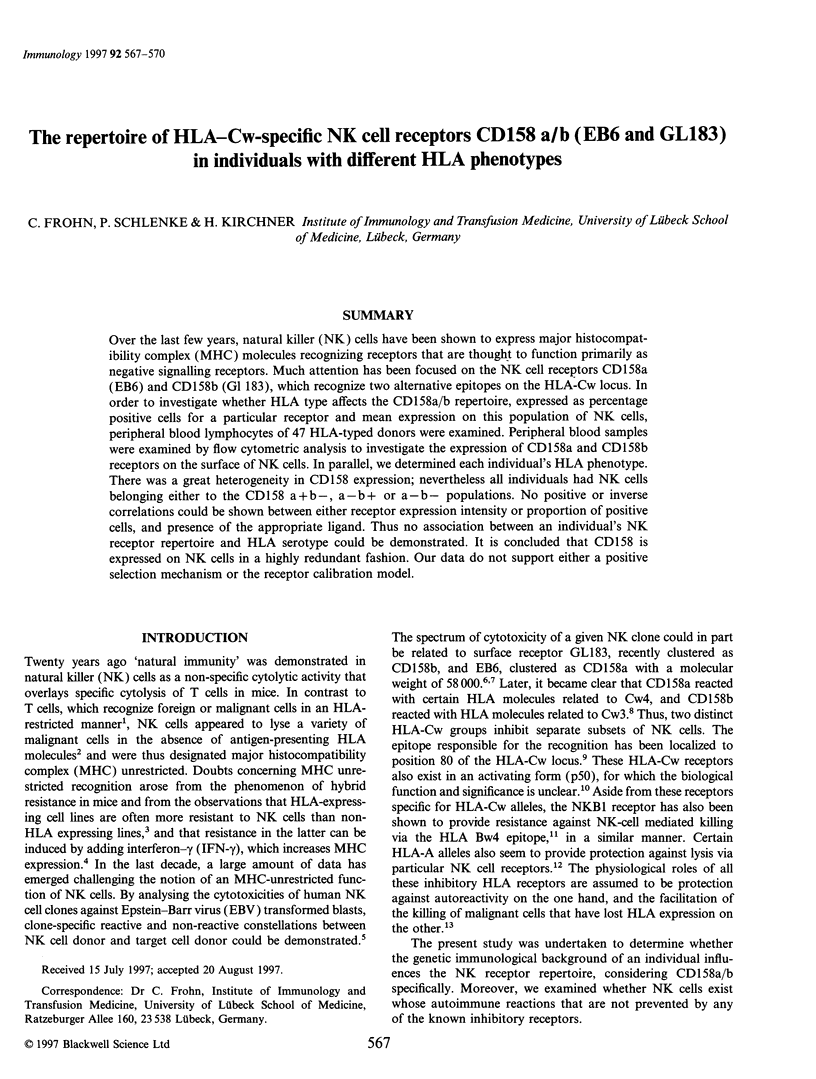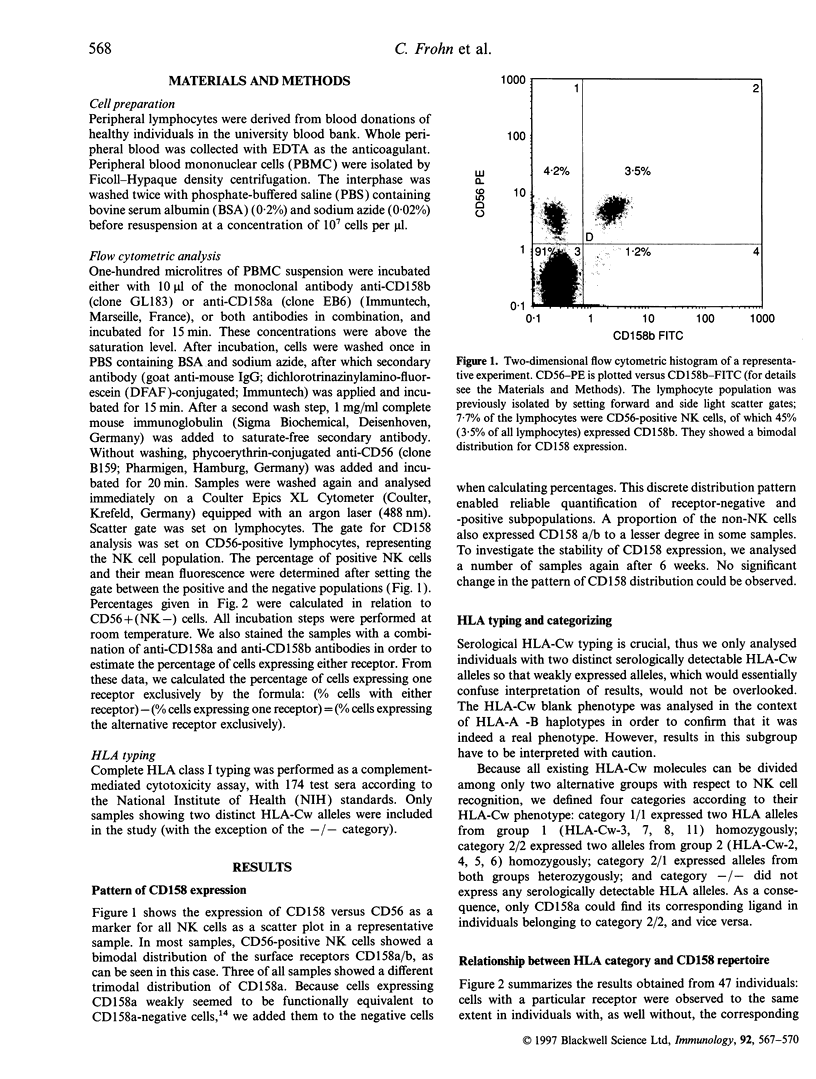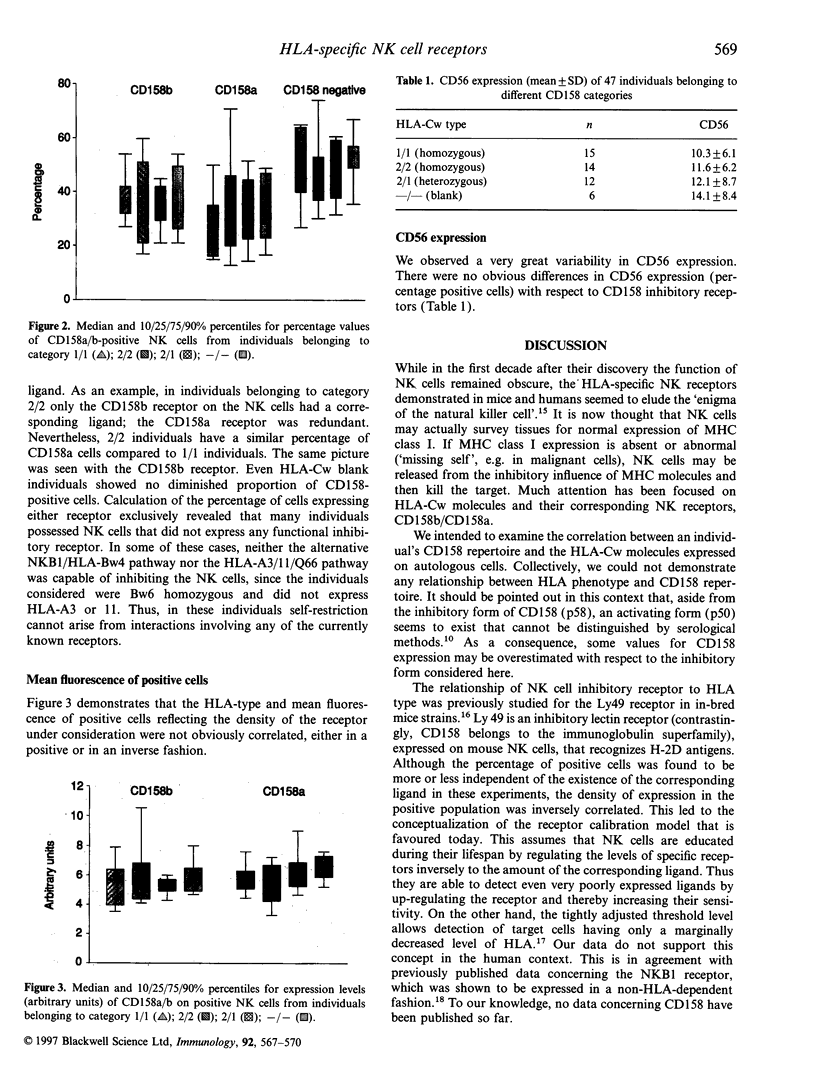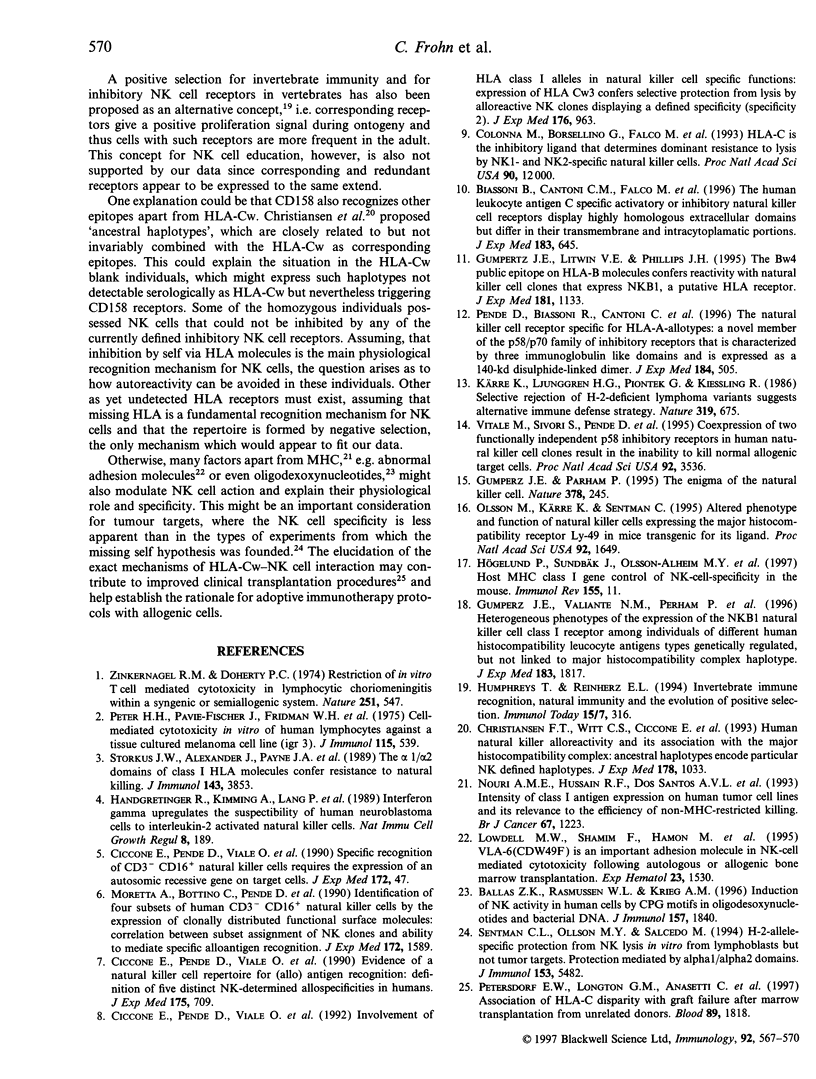Abstract
Over the last few years, natural killer (NK) cells have been shown to express major histocompatibility complex (MHC) molecules recognizing receptors that are thought to function primarily as negative signalling receptors. Much attention has been focused on the NK cell receptors CD158a (EB6) and CD158b (GI 183), which recognize two alternative epitopes on the HLA-Cw locus. In order to investigate whether HLA type affects the CD158a/b repertoire, expressed as percentage positive cells for a particular receptor and mean expression on this population of NK cells, peripheral blood lymphocytes of 47 HLA-typed donors were examined. Peripheral blood samples were examined by flow cytometric analysis to investigate the expression of CD158a and CD158b receptors on the surface of NK cells. In parallel, we determined each individual's HLA phenotype. There was a great heterogeneity in CD158 expression; nevertheless all individuals had NK cells belonging either to the CD158 a+b-, a-b+ or a-b- populations. No positive or inverse correlations could be shown between either receptor expression intensity or proportion of positive cells, and presence of the appropriate ligand. Thus no association between an individual's NK receptor repertoire and HLA serotype could be demonstrated. It is concluded that CD158 is expressed on NK cells in a highly redundant fashion. Our data do not support either a positive selection mechanism or the receptor calibration model.
Full text
PDF



Images in this article
Selected References
These references are in PubMed. This may not be the complete list of references from this article.
- Ballas Z. K., Rasmussen W. L., Krieg A. M. Induction of NK activity in murine and human cells by CpG motifs in oligodeoxynucleotides and bacterial DNA. J Immunol. 1996 Sep 1;157(5):1840–1845. [PubMed] [Google Scholar]
- Biassoni R., Cantoni C., Falco M., Verdiani S., Bottino C., Vitale M., Conte R., Poggi A., Moretta A., Moretta L. The human leukocyte antigen (HLA)-C-specific "activatory" or "inhibitory" natural killer cell receptors display highly homologous extracellular domains but differ in their transmembrane and intracytoplasmic portions. J Exp Med. 1996 Feb 1;183(2):645–650. doi: 10.1084/jem.183.2.645. [DOI] [PMC free article] [PubMed] [Google Scholar]
- Christiansen F. T., Witt C. S., Ciccone E., Townend D., Pende D., Viale D., Abraham L. J., Dawkins R. L., Moretta L. Human natural killer (NK) alloreactivity and its association with the major histocompatibility complex: ancestral haplotypes encode particular NK-defined haplotypes. J Exp Med. 1993 Sep 1;178(3):1033–1039. doi: 10.1084/jem.178.3.1033. [DOI] [PMC free article] [PubMed] [Google Scholar]
- Ciccone E., Pende D., Viale O., Tambussi G., Ferrini S., Biassoni R., Longo A., Guardiola J., Moretta A., Moretta L. Specific recognition of human CD3-CD16+ natural killer cells requires the expression of an autosomic recessive gene on target cells. J Exp Med. 1990 Jul 1;172(1):47–52. doi: 10.1084/jem.172.1.47. [DOI] [PMC free article] [PubMed] [Google Scholar]
- Ciccone E., Pende D., Viale O., Than A., Di Donato C., Orengo A. M., Biassoni R., Verdiani S., Amoroso A., Moretta A. Involvement of HLA class I alleles in natural killer (NK) cell-specific functions: expression of HLA-Cw3 confers selective protection from lysis by alloreactive NK clones displaying a defined specificity (specificity 2). J Exp Med. 1992 Oct 1;176(4):963–971. doi: 10.1084/jem.176.4.963. [DOI] [PMC free article] [PubMed] [Google Scholar]
- Colonna M., Borsellino G., Falco M., Ferrara G. B., Strominger J. L. HLA-C is the inhibitory ligand that determines dominant resistance to lysis by NK1- and NK2-specific natural killer cells. Proc Natl Acad Sci U S A. 1993 Dec 15;90(24):12000–12004. doi: 10.1073/pnas.90.24.12000. [DOI] [PMC free article] [PubMed] [Google Scholar]
- Gumperz J. E., Litwin V., Phillips J. H., Lanier L. L., Parham P. The Bw4 public epitope of HLA-B molecules confers reactivity with natural killer cell clones that express NKB1, a putative HLA receptor. J Exp Med. 1995 Mar 1;181(3):1133–1144. doi: 10.1084/jem.181.3.1133. [DOI] [PMC free article] [PubMed] [Google Scholar]
- Gumperz J. E., Parham P. The enigma of the natural killer cell. Nature. 1995 Nov 16;378(6554):245–248. doi: 10.1038/378245a0. [DOI] [PubMed] [Google Scholar]
- Gumperz J. E., Valiante N. M., Parham P., Lanier L. L., Tyan D. Heterogeneous phenotypes of expression of the NKB1 natural killer cell class I receptor among individuals of different human histocompatibility leukocyte antigens types appear genetically regulated, but not linked to major histocompatibililty complex haplotype. J Exp Med. 1996 Apr 1;183(4):1817–1827. doi: 10.1084/jem.183.4.1817. [DOI] [PMC free article] [PubMed] [Google Scholar]
- Handgretinger R., Kimmig A., Lang P., Daurer B., Kuci S., Bruchelt G., Treuner J., Niethammer D. Interferon-gamma upregulates the susceptibility of human neuroblastoma cells to interleukin-2-activated natural killer cells. Nat Immun Cell Growth Regul. 1989;8(4):189–196. [PubMed] [Google Scholar]
- Humphreys T., Reinherz E. L. Invertebrate immune recognition, natural immunity and the evolution of positive selection. Immunol Today. 1994 Jul;15(7):316–320. doi: 10.1016/0167-5699(94)90079-5. [DOI] [PubMed] [Google Scholar]
- Kärre K., Ljunggren H. G., Piontek G., Kiessling R. Selective rejection of H-2-deficient lymphoma variants suggests alternative immune defence strategy. Nature. 1986 Feb 20;319(6055):675–678. doi: 10.1038/319675a0. [DOI] [PubMed] [Google Scholar]
- Lowdell M. W., Shamim F., Hamon M., Macdonald I. D., Prentice H. G. VLA-6 (CDw49f) is an important adhesion molecule in NK cell-mediated cytotoxicity following autologous or allogeneic bone marrow transplantation. Exp Hematol. 1995 Dec;23(14):1530–1534. [PubMed] [Google Scholar]
- Moretta A., Bottino C., Pende D., Tripodi G., Tambussi G., Viale O., Orengo A., Barbaresi M., Merli A., Ciccone E. Identification of four subsets of human CD3-CD16+ natural killer (NK) cells by the expression of clonally distributed functional surface molecules: correlation between subset assignment of NK clones and ability to mediate specific alloantigen recognition. J Exp Med. 1990 Dec 1;172(6):1589–1598. doi: 10.1084/jem.172.6.1589. [DOI] [PMC free article] [PubMed] [Google Scholar]
- Nouri A. M., Hussain R. F., Dos Santos A. V., Mansouri M., Oliver R. T. Intensity of class I antigen expression on human tumour cell lines and its relevance to the efficiency of non-MHC-restricted killing. Br J Cancer. 1993 Jun;67(6):1223–1228. doi: 10.1038/bjc.1993.229. [DOI] [PMC free article] [PubMed] [Google Scholar]
- Olsson M. Y., Kärre K., Sentman C. L. Altered phenotype and function of natural killer cells expressing the major histocompatibility complex receptor Ly-49 in mice transgenic for its ligand. Proc Natl Acad Sci U S A. 1995 Feb 28;92(5):1649–1653. doi: 10.1073/pnas.92.5.1649. [DOI] [PMC free article] [PubMed] [Google Scholar]
- Pende D., Biassoni R., Cantoni C., Verdiani S., Falco M., di Donato C., Accame L., Bottino C., Moretta A., Moretta L. The natural killer cell receptor specific for HLA-A allotypes: a novel member of the p58/p70 family of inhibitory receptors that is characterized by three immunoglobulin-like domains and is expressed as a 140-kD disulphide-linked dimer. J Exp Med. 1996 Aug 1;184(2):505–518. doi: 10.1084/jem.184.2.505. [DOI] [PMC free article] [PubMed] [Google Scholar]
- Peter H. H., Pavie-Fischer J., Fridman W. H., Aubert C., Cesarini J. P., Roubin R., Kourilsky F. M. Cell-mediate cytotoxicity in vitro of human lymphocytes against a tissue culture melanoma cell line (igr3). J Immunol. 1975 Aug;115(2):539–548. [PubMed] [Google Scholar]
- Petersdorf E. W., Longton G. M., Anasetti C., Mickelson E. M., McKinney S. K., Smith A. G., Martin P. J., Hansen J. A. Association of HLA-C disparity with graft failure after marrow transplantation from unrelated donors. Blood. 1997 Mar 1;89(5):1818–1823. [PubMed] [Google Scholar]
- Sentman C. L., Olsson M. Y., Salcedo M., Höglund P., Lendahl U., Käre K. H-2 allele-specific protection from NK cell lysis in vitro for lymphoblasts but not tumor targets. Protection mediated by alpha 1/alpha 2 domains. J Immunol. 1994 Dec 15;153(12):5482–5490. [PubMed] [Google Scholar]
- Storkus W. J., Alexander J., Payne J. A., Cresswell P., Dawson J. R. The alpha 1/alpha 2 domains of class I HLA molecules confer resistance to natural killing. J Immunol. 1989 Dec 1;143(11):3853–3857. [PubMed] [Google Scholar]
- Vitale M., Sivori S., Pende D., Moretta L., Moretta A. Coexpression of two functionally independent p58 inhibitory receptors in human natural killer cell clones results in the inability to kill all normal allogeneic target cells. Proc Natl Acad Sci U S A. 1995 Apr 11;92(8):3536–3540. doi: 10.1073/pnas.92.8.3536. [DOI] [PMC free article] [PubMed] [Google Scholar]
- Zinkernagel R. M., Doherty P. C. Immunological surveillance against altered self components by sensitised T lymphocytes in lymphocytic choriomeningitis. Nature. 1974 Oct 11;251(5475):547–548. doi: 10.1038/251547a0. [DOI] [PubMed] [Google Scholar]




